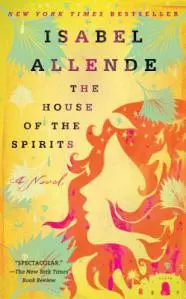Summary,
To start off with a brief summary, The House of the Spirits follows the del Valle family throughout many generations. They live in South America, though it is never specified which country they live in, the reader can assume based on the historical events that the family lives in Chile. The novel begins following the first generation:
Nívea and her husband Severo as they are raising their children. Nívea has a LOT of children, and the focus is on Clara and her sister Rosa. Clara, meaning clear in Spanish, has supernatural powers, while Rosa is supernaturally beautiful (seen below in fan art).
The House of the Spirits employs a dearth of magical realism, particularly at the beginning of the novel. Personally, I love reading magical realism because you read a description like, “more beautiful than ever, her hair strikingly green,” and you just go with it. After Rosa’s unfortunate death, Clara becomes an introvert, refusing to speak at all. She eventually marries Esteban, her dead sister’s finance. Esteban and Clara consummate a marriage that is loving, though perhaps platonic. They have three children: Nicolás, Jamie and Blanca. Nicolás is an eccentric soul, taken to salsa, religion and the most striking of which, nudity. Jamie is the most kind, giving character. He dedicates his life to the cause of helping others, literally giving clothes off of himself to give to those who do not have any. Blanca is characterized by her capacity to love, deeply. She falls in love with Pedro (the third) and they end up being together. Blanca’s child, Alba, is another central character to the novel. She is another powerful del Valle woman, and her power for compassion allowed many people during the Chilean revolution to escape from harm.
At the background, and later the forefront, of the family drama, is the Chilean revolution. If none of you are aware of the specifics, Chile was briefly controlled by a Marxist government, Salvador Allende, however he was soon overthrown in a military coup. To make this story even more convoluted, Isabel Allende, the author, is actually the niece (correct me if I’m wrong), of Salvador Allende, or ‘The President,’ as he is described in the novel.
I will go into more character analysis in another post, since we are forgetting about a lot of people here, to make it a bit shorter, but I am going to move on to what I liked, and what I didn’t like about the novel.
The Good, the Great, the Mastery
For many, it is almost impossible to discuss The House of the Spirits without comparing it to a Marquez novel. It is true, both of these books heavily rely on the use of magical realism. But to do this is showing an ignorance in Latin American literature. Almost ALL books published by this genre of authors employs magical realism. Simply put, Allende and Marquez are just perhaps the two most well known and most masterful Latin American authors of their times.

(how great is this picture of Marquez)
I have heard critiques of this novel that she “tells, not shows,” and I would like to discount that. Magical realism is ALL about telling, and the reader accepting how something is. Allende employs a style which is very frank in her descriptions. Esteban is proud, Alba is stubborn. I found this style very easy to pace and read, but perhaps for others it was not the same way. Additionally I have heard critiques about the repeated use of foreshadowing in her novels. Personally, I found the foreshadowing interesting. It made me want to flip back through the book and think, where did she say this was going to happen? But I can understand this critique because, as a warning, foreshadowing is employed very often.
I found the most compelling part of the novel was Allende’s ability to weave through so many characters. Characters like Amanda, who you thought were never going to appear again suddenly take a main role in the narration. I thought that the characters were developed deeply and with apparent ease. For example, we never really hear much about Amanda, but I can imagine the woman who grew up too soon, has a jaded look on the world, sees Jamie’s love for her and immediately leaves. Additionally I think that the extreme characters like Jamie and Nicolás further add to the complexity of the story. Jamie is not meant to be a character that really exists in life. We all know the hyperbolic idiom, “give the shirt off one’s back,” which Jamie does. It is clear that Allende is using Jamie as a device in this novel, and personally I found it very effective (I cried when Jamie died…).
I also found these characters deep and powerful. The women of the Allende family made me proud, simply as a reader. Though we know that Esteban is the powerful patriarch, his power is diminished by Clara. It is Clara who brings the life into the household. After her death, it is silent, even the cats run away.
Additionally despite the very fast pasted and tumultuous topic that Allende was dealing with, the background being the Chilean revolution, I thought she did a beautiful job of weaving through scenery.
I want to start ‘The Bad’ section by prefacing, I really enjoyed The House of the Spirits, it captivated me throughout the novel, I laughed, marked down favorite quotes, and all of those good things you do with good books,
The Bad (and my apparent ignorance):

As I have said multiple times, The House of the Spirits discusses Chile’s complicated past, including the death of ‘The President’ and the military control the country later experienced. Personally, I did not know much about Chile’s history. That is a terrible oversight of mine, especially as a Latin American woman, however it was never really taught in schools, and I did not study history, so this novel was really my first take on the history behind these bloody events. The revolution happens very quickly in the novel. I would estimate that 4/5th of the novel covers the del Valle family, while 1/5 goes through their time in the revolution. Honestly, it might even be a smaller minority. I would like to say that this might be accurate, the revolution might have happened suddenly like that for the people in Chile at the time. Perhaps the election of the communist party really was as sudden as it seemed in the novel (although ‘The President’ did tell us it was going to happen). And perhaps the end of regime was as short as it seemed. It is hard to keep track of timelines in the novel, because we are going through four generations of del Valle women (if you want to say that Nana plays a key role, then five). So the communist party was really in power for three years in Chile (thank you wikipedia) but it feels like about 15 pages in the novel. Keep in mind that the novel must take place over around 60 years, so I guess comparatively, perhaps it is accurate. Personally, I felt like that section was a bit rushed. The novel was getting upwards of 500 words and it was time to end, and Allende seemed to rush through.
Overall
The House of the Spirits is a compelling novel, and Allende’s first of many. Today she is one of the most popular, if not the most read, Latin American writer and it is not hard to see why, after this novel. The book started off as a letter to her grandfather, discussing their history, after she found out that he was dying and then turned into this beautiful book.
I would definitely recommend The House of the Spirits to any reader who has a taste for magical realism, and simply beautiful prose. Allende has the ability to string together any sentence and make you go back and have to read it again. And, as my friend pointed out, it does a great job at characterizing the Latin American anger that is so common in the countries where the government has repeatedly failed them.
Rating
★★★★
Though I thought it was a powerful novel, it did not make me think or wonder as much as some of my other favorite books. But it is definitely worth a buy and a reread from me!












